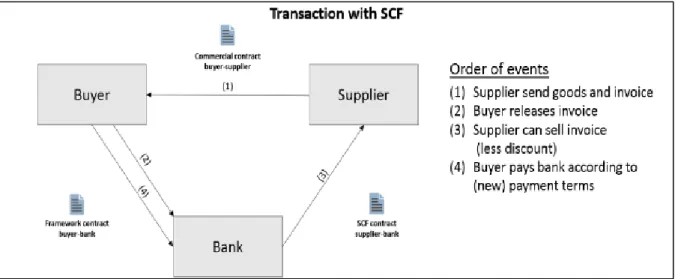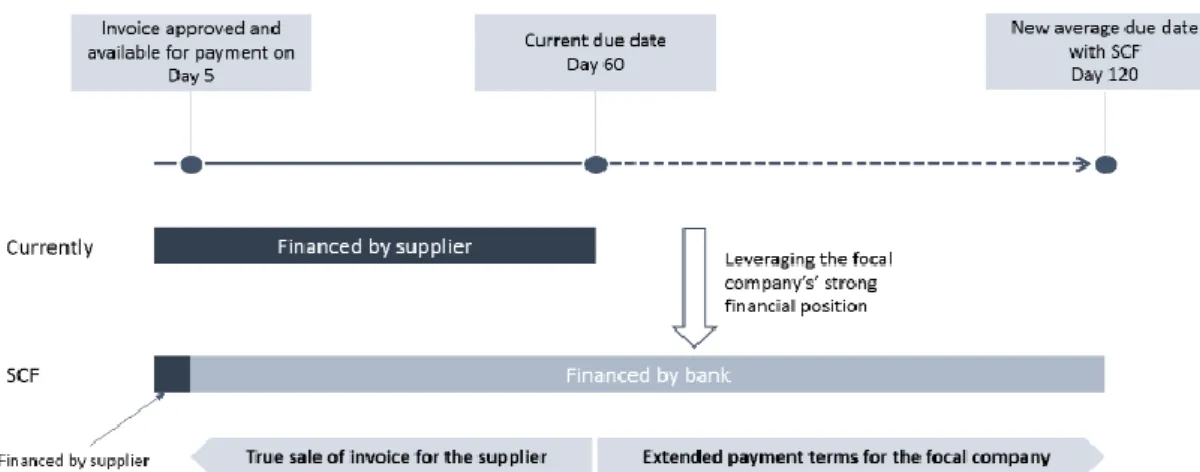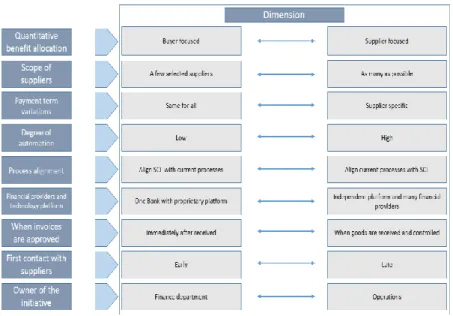Figure 1 – The concept of a buyer-centric supplier payables financing solution
Supply Chain Finance (SCF)
A buyer-centric supplier payables financing
solution
Martin Jemdahl 28th January 2016
SCF is commonly described as a ‘win-win’ solution for a buying firm and suppliers. It allows the buyer and its suppliers to reduce tied up working capital which can creates substantial benefits for all involved. For a financially stable buyer, a buyer-centric supply chain finance initiative can enable it to leverage its financial position and reach efficiencies in cash flows and working capital management while also cultivating supplier relations by offer similar benefits to them. Released working capital allows for more financial room to manoeuver and decrease the reliance on external financing for operational activities and investments.
Within a supply chain involving more than one company, there is dilemma between different supply chain actors working to obtaining the same type of financial improvement. For example, extending payment terms transfers cost of capital and risk to other actors in the supply chain. While the buyer may experience lower credit risk, the supplier needs additional financing to cover the lengthened period without payment for their delivered goods and services. In situations where suppliers have restricted access to short-terms financing, the shifting costs can lead to serious consequences for the supplier and the buying firm.
In situations where suppliers have restricted access to short-terms financing, the shifting costs can lead to serious consequences for the supplier and the buying firm.
Less stable suppliers result in increased supplier-base risk, as suppliers can be forced to delay their purchasing, cut back on inventories and hold back on service levels and quality. Eventually, increased costs and reduced quality for the suppliers will likely be included in the buying firm’s cost for purchased goods. There is a general trend where payments from customers takes longer and ties up capital in receivables. At the same time demand for short lead times and high service levels ties up capital in inventories. Increasing global competition create price pressure, lower demand and decreased gross margins in many industries. For firms to stay competitive and profitable, there is a need for investments in new innovative products and increased efficiency. As a result, firms are looking to find capital internally and trying to understand how the physical supply chain is impacting cash flow and working capital management. The last years there has been an increasing demand for financing solutions within the supply chain to mitigate some of the negative effects. The perhaps most straight forward and common supply chain solution is presented in figure 1:
Figure 2 – Financing flow
(1) Supplier send goods and invoice
The contracts structure is unchanged. To avoid that the SCF set-up is considered as a financial settlement from an accounting perspective, it does not mention SCF and the agreement regarding it. The change in the contract is often only with the payment terms and conditions.
(2) Buyer approve and release invoice
The focal company takes responsibility for paying the bank in full on due date and appoints the bank to act as a paying agent for the focal company.
(3) Supplier can sell invoice (less discount)
The supplier can get payment for the invoice at any time between the approval and due date. The sale is a true-sale, and not considered as a loan. Thus, the suppliers are paid for their goods from a balance sheet perspective. The contract between the supplier and the bank describes the terms and conditions for the supplier to sell receivables on a true-sale basis. As the bank’s risk is toward the focal company, the discount is based on the buyer’s credit worthiness. The financial institutions acts as ‘payment agents’ for the focal firm, handling payments to suppliers, in order to avoid reclassification of payables to debt.
(4) Buyer pays bank the full invoice value on due date according to (new) payment terms By enabling the supplier to get paid in advance at a favorable discount rate, the general idea is that the buyer can extend the payment terms in return. The financing flow is illustrated in figure 2.
SCF-Relevance
For companies with adequate supplier bases and strong credit rating, SCF can be a relative ‘simple’ way of improving working capital, releasing cash, decrease
supply chain risks and improving buyer-supplier relations.
The Economic Value Added (EVA) can be increased for both the buying firm and its suppliers. For the buying firm, the freed working capital reduces the cost of capital. Furthermore, the cash can be utilized to improve the profits if wisely invested. It can be shown that working capital management is of extra importance for a growth company, both enabling investments and mitigating the additional need for tied working capital.
For a supplier using expensive receivable financing solutions such as factoring, SCF generally lead to a credit arbitrage, where the supplier can get paid immediately, to a much lower discount rate. Suppliers financing the credit internally experience a better cash-to-cash cycle and get access to capital at a low cost. The supplier’s access to capital can lead to a lower supply risk for the buyer. The supplier has adequate access to capital when purchasing raw-material and/or can invest to improve production and lead-times.
SCF project
A project framework can be seen in figure 2. It is important to understand the purpose of the framework is to act as a guideline, and not to be followed exactly.
Figure 5 – Characteristics of suitable suppliers
Figure 5 – Aspects to evaluate
Every SCF project is unique, and need its own consideration depending on the business context. The framework presents common aspects that are important to evaluate and decide on. The project should not to be static in the early phases, and the project team need to be flexible when conducting their work. Examples to consider in the pre-study and when defining the strategy is presented in figure 4 and 5.
It is difficult to find generic and objective criteria to tell whether SCF is suitable for a focal firm. The differences in motivation, the numerous potential benefits, and differences in need of process changes and the difficulty with defining supplier relations makes every SCF case different. Furthermore, as highlighted in the
study, without discussing with suppliers, it is difficult to know how they value to benefits from SCF. Ultimately, the focal firm need to evaluate its expected benefits with the expected costs and risk in order the make a SCF decision. In the study it is elaborated on the key aspects relevant when deciding on SCF. It is up to the individual firm to put emphasize on the aspects that are of most importance for them.
Critical Success Factors
Critical success factors identified are presented below. It is however still up to the individual companies to conduct adequate activities in order to ensure a successful SCF project. The thesis provides some examples of how it can be achieved, elaborating on the framework (figure 2), but the firm need to evaluate the CSFs, relate them to their business context and introduce them into their project in a suitable manner. The following CSFs where identified, the first three being the most critical:
The right banking and platform provider
partner(s)
Internal sponsorship and top-management
support
Degree of automation and order-to-pay
process alignment
Buying company in charge of the initiative
Scope of suppliers and effective
on-boarding
Good supplier relations and communication
Internal acceptance of changes in job
designs and processes
Performance measures and clear goals
Excellent project management
Internal alignment
Conclusion
Supply chain finance can be a powerful tool to free working capital, injecting additional cash into the company, and mitigate supply risks. The strength in SCF is that it avoids suppliers from getting a negative working capital effect, instead providing benefits to them as well. However, SCF is not a 'one size fit all' nor suitable for all firms. Therefore, a SCF implementation needs careful consideration before it is initiated.


